|
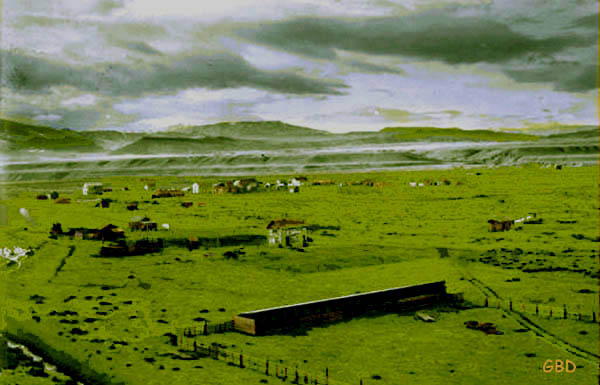
Cody, 1901. Artwork by based on photo by L. E. Webster (Lewis Elmo Webster).
Webster (1878-1963) was the son of William P. Webster, the first postmaster of Cody. The Websters arrived in the area
in 1893 initialing settling at Ishawooa in the Absarokas. The younger Webster was a "jack of all trades" and was not only a photographer, but acted with his father as
a guide, he worked as a surveyor's assistant and as a wolfer. He was an initial member of the Cody Coronet Band formed in 1902 and played alto Coronet. He was also a member of the
Woodmen of the World. About 1912, he moved to San Fernando, California.There, he worked as a photographer and surveyor. Later he owned
a grocery store.
As a wolfer, he wrote to hunter-Trader-Trapper Magazine, October 1905, p. 61:
We have all the fur bearing
animals found anywhere In the northwest, such as beaver, mink, marten, fisher, otter, muskrat, weasel, coyote, wolf, fox and skunk: also mountain lions, all of which I have caught in the state, but I keep most of my furs for around my den.
There is no bounty paid for anything here but the coyote, which is $2.50, and wolf $8.00. and 25 to 50 cents private stockman's bounty. As for the care of the hides after caught. I case the hides of the otter, mink, marten, muskrat and weasel with two boards and a wedge. Take two 3-lnch boards for the larger hides and others according to the size of the hide, then round the outside corner on one end to fit the head and nose, then take a long wedge and wedge them apart as tight as you wish them stretched.
The beaver and badger I stretch as round as possible, ripping them open on the belly and inside of legs. The hides of the coyote, wolf and bear are stretched as near the shape of the animal as possible by ripping down the belly and out on the legs.
I tan my own hides with a dry tan. By using a fresh hide it only takes about a week in the tan. I also tan deer, elk and antelope hides for buckskin to be used in making gloves and clothing.
L. E. Webster, Cody.
In addition to the bounty, Webster would receive anything paid for the hides or pelts.At Irma Flat, Felix Alston's General Store advertised the "highest market price paid for hides and pelts." See
Wyoming Dispatch, December 20, 1902, p. 4. For general discussion of wolfers, see
wolfers
Webster documented with his photographs some of the early businesses in Cody. In 1905 well-known Collier's "special correspondent," Arthur Brown Ruhn (1876-1935) passed through
Cody as a part of his report, "Pioneers of the Dry Places," Collier's Magazine, November 11, 1905, p. 17-19. The two most impressive things he noted of
the town were a tame buffalo who made his home in a stall in a local barn and two women who would come into the Irma during the "season" for the weekly dance.
Of the former, he wrote:
Cody is a place full of life and cheer. They had a wild buffalo in Cody while we were there. I refer to his state of mind, not to the fact that he was unconfined.
He was kept in a stable in a box-stall, and it was that which made him wild. He had been given away a number of times, very generously, but the recipients were
never able to remove him. Once, I believe, he was hoisted in a wagon, tied down like Gulliver by the Liliputians, but he broke the ropes, and it was with great
difficulty and peril that he was finally lassoed and towed back to the box-stall. When we were in Cody he was monarch of his barn, and a man fed him by climbing
craftily up into the hayloft and dropping hay down through the ceiling. Last spring a couple of mounted robbers rode into Cody, held up the cashier in the bank
directly across the street from Buffalo Bill’s hotel, shot and killed one man who fired at them, jumped on their ponies, and were up and away half an hour ahead
of the posse that started after them—certainly an odd thing to happen in a town where the drug store windows are full of kodak films, and you can buy all the
magazines as soon as they are out on the news stands in the East.
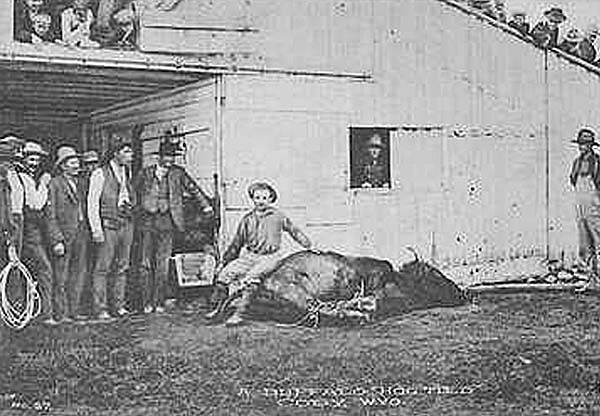
A hog-tied Buffalo, Cody, C. 1905, Photo by F.J. Hiscock
Dr. A. H. Cordier, a well-known hunter, passed through
Cody on his way to hunting of elk above Ishawooa Pass. In his "Some Big Game Hunts, Union Bank Note Company, Kansas City, 1911, he described
Cody:
We changed cars at Toluca, Montana. Toluca is quite a metropolis composed of a dept, a section house, two Cody hoel signs and a large prairie dog
population. Here we practiced with a target rifle for an hour or two while waiting for the train to leave for Cody, a
distance of one hundred and thirty miles. This is an all day ride, including the stops the engineer and fireman made when they went to shoot prairie chickens along the
right of way. At six o'clock on Saturday, September 9th, we arrived at Cody, where we were met by Fred.
The Irma Hotel, owned by "Buffalo Bill," is a hostelry that reflects much credit on the little town of Cody. This
little town of the Shoshone foot hills is a thriving burg of one thousand inhabitants and is a truly typical border or frontier town. Supported as it is by
ranchmen, miners and cowboys, it presents an animation out of all proportion to its size.
Undoubtedly contributing to the "animation" were the saloons. By 1903, there were some ten saloons in the town. Five of the more prominent
were Richard A. Roth's Saloon, Ben Primm's "Cody Exchange," Fred Primm's Cody Hotel Saloon, the Buffalo Hump Saloon and Chop House, and the Irma Hotel Bar.
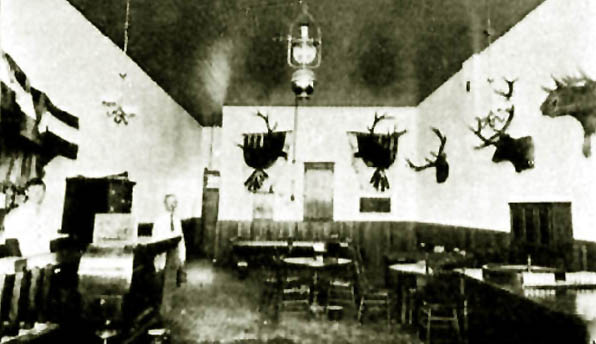
Interior Richard A. Roth's Saloon, 1903.
Roth came to Cody in 1902. He was a charter member and secretary of the local aerie of the Fraternal Order of Eagles. He constructed the depicted saloon
depicted in 1903 for $3,000. In 1905 Roth sold the saloon apparently receiving a substantial sum. From
there the mystery begins. On November 20 the Omaha Daily Bee reported:
CODY, Wyo., Nov. 19. As they were
about to board a train for Denver, with
tickets furnished by telegraph from that
place. Hilda Ahlstrom and Mary Kramer,
who have been in Cody for several years.
were detained by deputy sheriff Henry
Hammit and held to await the Investigation
as to the death of R. A. Roth, a
prominent business man of this place, who
died under most mysterious circumstances.
During the afternoon and evening until
midnight. Roth and the two women had
been driving together. Later Roth was
found in a demented condition. He died,
as the physicians state, with every symptom
of arsenical poisoning, and the local
order of Eagles, to which Roth belonged,
has sent the stomach to Denver for anlysis.
Roth recently sold his saloon business
here and was known to have a large
sum of money on him. Only $50 was found
by the coroner.
A later report indicated that physicians were split as to the cause of death, two believing
arsenical poisoning and two from Bright's disease. From there the mystery remains,
what happened to Roth's money and what happened to Ahlstrom and Kramer?
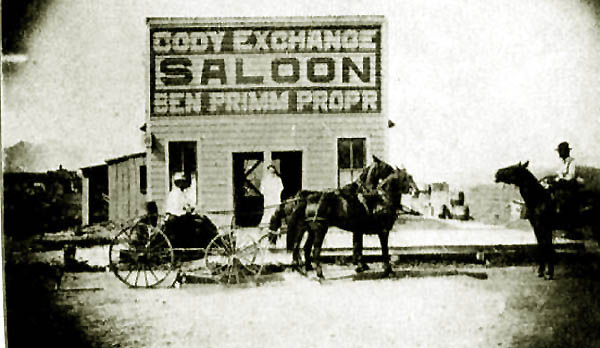
Ben Primm's Cody Exchange Saloon, 1903.
Both Primm's and Roth's saloon had gambling and both had their gambling banks robbed by masked
robbers. At Primm's about 14 men were engaged in a "social chat" (See Dispatch, Sec. 27, 1902, p. 1) when the roulette bank was robbed. At
Roth's the Faro table was robbed. In neither instance, however,were the patrons robbed. The robbers were never
caught.
The Sheridan Post, Industrial Edition [an advertising supplement], Sept 30, 1903, in a blurb
featuring Primm's saloon, noted that Primm came to Wyoming at age 17 from Illinois in 1886, "he
liked the free and easy ways and bright sunshine of the West, and has remained ever since."
In reality, it was probably not the bright sunshine which kept Primm in Wyoming. For at least a part of the time
he may have been suffering from prison pallor as a guest of the State. In 1895, he was convicted in Johnson County of
having enticed an old man, sixty years old, into a house of ill repute, getting him drunk, and robbing him in the alley behind the
Buffalo Bulletin. Following release from prison, he was restored to his civil rights.
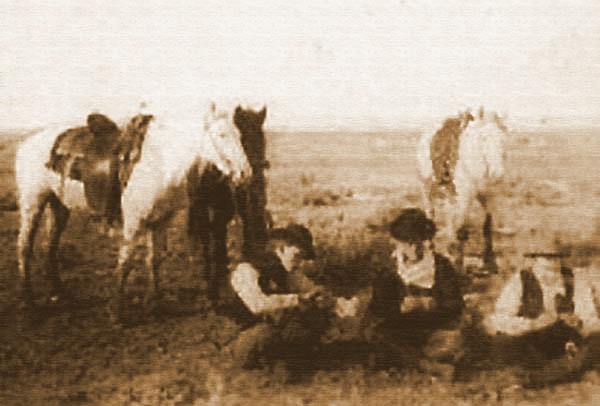
Left to right: William J. "Billie" Osgood, Fred Burns, and Ben Primm, approx. 1902.
Bill Osgood and Fred Burns had worked for Colonel Cody. Osgood (1879-1950) arrived in the area about 1899 following the end of the Spanish-American War in which
he had served in Co. "F" of the 1st Arkansas Infantry. Company F made it only as far as Camp Thomas at Chickamauga, Georgia, before being
mustered out. He at first worked as a cowboy
along the Yellowstone River. He was subsequently employed by Col. Cody as a "tallyho driver." With the opening of Col. Cody's
Irma Hotel he was employed in the office and in the bar as the night bartender.
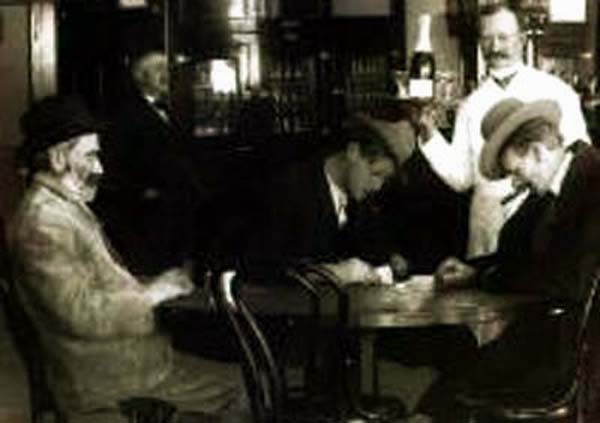
William Osgood, center, Irma Bar, approx. 1903.
In 1902, gold had been discovered at Goldfield, Nevada. With promised fortunes to be made in Nevada, Goldfield, Osgood moved on from
Cody. The Goldfield quickly soared to a population of approximately
20,000 and with unharmonious labor problems which required President Theodore Roosevelt to send in
troops, just as quickly plummeted to 4,838 in 1910. By 2010, the population was 260. Gold mining was apparently not a
path to riches. By January 1907 Osgood was employed by the O'Keefe transer Company. See
Tonopah Bonanza, January 26, 1907, p. 7. In 1908, Osgood was sued in the Justice Court, Goldfield Township, by Thomas Boland and Frank P. Burk for
$41.25 along for a $100.00 loan. He and his new bride and child moved to the Bay Area of California where, among other things,
he worked as a guide in San Francisco's Chinatown and the Barbary Coast. He died after a two year illness in 1950 and is interred in the Golden Gate
National Cemetery.
On February 29, 1904, the Laramie Republican reported that Primm had died of a sudden "heart failure." A week later on March 8, the Sheridan Post revealed that the sudden heart failure
his heart problem was as a result of a fight with Deputy Game Warden Carl Hammitt. The Cheyenne Wyoming Tribune, however, referred to to his death as under
"Suspicious circumstances after a beating received from an officer." See the
Tribune Feb 27, 1904, p. 3. Shortly before his death, Primm had married
the daughter of the Reverend Sam Small, a temperance advocate. The Thermopolis Record referred to Small as the
"pyrotechnic evangelist." Primm's estate amounted to approximately
$1500. Earlier, Mrs. Primm had engaged in a "Common Law" marriage with Dr. Julius Schuelke and applied to the Courts for
a widow's share of his estate. She lost. See Weidenhoft v. Primm, 10 Wyo 342, 94 Pac. 451 (1908). Wyoming does not recognize
Common Law marriages. Within a short time, Mrs. Primm remarried several times to such an extent that the Record, March 14, 1908, p. 1, referred to her as
"Mrs Lois Small-Schulke [sic]-Primm-Jolly." Dr. Schuelke died on the stage to Casper apparently from a morphine overdose. The Lander Clipper, August 7, 1903, p. 1, referred to it as
suicide.
With the question of Primm's heirs being resolved, in 1911 the Exchange building was converted into a theatre.
By the early 1900's, Cody had at least three lodging houses in addition to Col. Cody's Irma Hotel featured on a subsequent page: (a.)the Hart Mountain Inn constructed by David H. "Badland Dave" McFall (1842-1942) at the corner of Beck and 3rd;
(b.) The Cody Hotel, on Sheridan Avenue; and (c.) the Chamberlin Hotel. Additionally on the town's eastside were, as indicated on the next page, several facilites
that appealed to lonesome cowboys..
The Hart Mountain Inn

Hart Mountain Inn, looking east on Beck Ave toward 14th, 1906 Photo engraving Wyoming Industrial Journal.
From the left: The Methodist-Episcopal church, Walter Braden & Son's "Red Star Livery and Feed Barn, Scholes & Owens Blacksmiths, J. M Frost's Council Saloon and "Family Liquor Store,
the Cody Bottling Works, and the hotel. The Saloon advertised free lunch every afternoon and evening.
David McFall had served in the
Civil War (7th Regiment Iowa Infantry). Following the war he spent some time in the South, but in
1873 enlisted at Omaha Barracks as a private and served in the Indian Wars. By 1893, he was prospecting north of the Stinking Water. In 1898 he constructed the hotel.
David apparently thought highly of himself as a hunter and guide. The sobriquet "Badland Dave" was apparently derived from an anonymous cartoon and poem which appeared in the Enterprise, January 25, 1906:
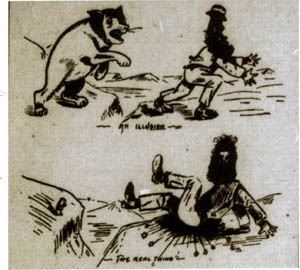
"Although Bad Land Dave is a most noted scout, yet there have been times when a prairie dog appeared to be as large as a grizzly."
A DAY S WORK FOR BAD LAND DAVE
Bad Land Dave is he durn best feller yet,
For he cleaned out the country you can bet.
One morning he kill five bears, just for fun.
But lookin round, he saw his work was just begun;
For a pack of forty wolves or more was followin o him
When he turned in his saddle and killed em all,
By gin.
Then twenty mountain lions a followin up his trail
Was enough to make an ordinary scout turn pale;
But Dave left all the lions laying in a line,
The cooly road off into the Bad Land pine.
And there he fest a duel with an old Sioux Brave,
And it looked for a while as if they were a measuring
Of their graves,
But Dave is just the feller that ill everyone surprise,
As I recon that s the reason that they both are
Yet alive.

Hart Mountain Inn, undated.
The name of the anonymous artist and poet was not revealed for some forty-eight years, although McFall knew who it was.
It was editor
Hook's brother John, a commercial artist.
In 1902, McFall advertised the following rates: transient $1.50, meal tickets for 21 meals $5.25, Room and Board by the month $1.00 a day, single meals 35 cents,
beds 35 cents. McFall served as town clerk for the town. He was commonly referred to as "Colonel, a title which one writer for the Northern
Wyoming Herald called " sympathetic." McFall was a member of Grand Army of the Republic. The hotel was
sold to Hillis Jordan (1874-1937) about 1912. During the 1912 election McFall was accused by the Northern Wyoming Herald of various ill
poltical deeds exemplified by the following headlines:

Headlines Northrn Wyoming Herald, October 25, 1912.
The opening salvo of lead story started out:
True to the characteristics which featured his career as a soldier when the engagement first opened, Dave McFall sympathetically termed "Colonel" occupied
a position in the rear ranks in the Cody opera house while the atmosphere was first pierced with sounds of the opening volley, McFall pursuing the tactics which
characterized his military course of life was seen beating a hasty retreat up the alley and rumor has it that the old war mule is
still in full retreat with absolute disregard to the location of the commissary.
The headline as to the "Miraculous escape from death on Rattlesnake" was a story about the brakes on Martin Kennedy's lumber wagon failing while he was going down the steep grade
on Rattlesnake Mountain.
The following week the accusations against McFall continued with the headlines for October 30:

Headlines Northern Wyoming Herald, October 30, 1912.
In 1916, the McFalls left Cody. After having pilloried Dave McFall four years before, in a one paragraph report of their
departure, the Herald on December 15, 1916, referred to them as
an "excellent couple" and reported that "They will be missed greatly." The story was near another story relating that the
24 boys in the school domestic science class had cooked their first dish cream of wheat with
prunes. In the preparation of the cream of wheat the boys split eight prunes.
In 1925, Hillis Jordan sold the Inn to J. P. Weber. Jordan had orignally worked for
Captain Belknap and homesteaded south of Ishawooa.
/p>
Next Page: Chamberlin Hotel.
|